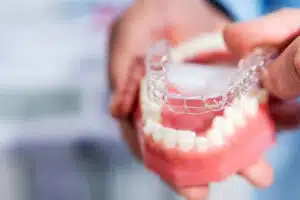Invisalign is an increasingly popular orthodontic treatment that offers a discreet and comfortable alternative to traditional metal braces. Many people are turning to Invisalign to straighten their teeth without the noticeable appearance of metal wires and brackets. However, before starting Invisalign treatment, it’s important to understand not only how it works but also what to expect in terms of Invisalign treatment length.
What Does Invisalign Treatment Do?
Invisalign treatment is designed to straighten teeth and correct bite issues using a series of clear, custom-made aligners. These aligners work by gradually shifting your teeth into the correct positions over time. Unlike traditional metal braces, Invisalign aligners are removable, making them a more flexible and discreet option for patients.
Aligning Teeth
The main goal of Invisalign is to align your teeth into a more functional and aesthetically pleasing position. The clear aligners are specifically designed to apply gentle pressure to certain areas of your teeth, gradually moving them into place.
Each set of aligners is worn for about one to two weeks, and as you progress through each new set, your teeth slowly shift toward the desired alignment. This process helps achieve a straighter smile and a healthier bite without the discomfort and visibility of traditional braces.
Improving Oral Health
In addition to the cosmetic benefits, Invisalign treatment can also improve your overall oral health. Misaligned teeth can contribute to various dental problems, such as difficulty cleaning between teeth, which can lead to plaque buildup, cavities, and gum disease. By straightening your teeth, Invisalign helps to create better alignment, making it easier to maintain proper oral hygiene.
Correcting bite issues such as overbites, underbites, and crossbites with Invisalign can also improve your ability to chew, speak, and even breathe more easily. By fixing these problems, Invisalign can help prevent long-term wear and tear on your teeth, reduce the risk of jaw pain, and alleviate other related issues.
Target Issues Treated by Invisalign
Invisalign is a versatile treatment option that can address a wide range of orthodontic issues, including:
- Overbite: When the upper teeth overlap the lower teeth too much.
- Underbite: When the lower teeth protrude beyond the upper teeth.
- Crossbite: When some of your upper teeth sit inside your lower teeth.
- Crowding: When there isn’t enough space for your teeth to align properly.
- Spacing: When there are gaps between your teeth.
What is the Invisalign Treatment Length?
The Invisalign treatment length depends on several factors, including the complexity of your case, your age, and how consistently you wear your aligners. On average, Invisalign treatment takes about 12 to 18 months to complete, though some patients may finish in as little as six months, while others may take longer, depending on their specific dental needs.
Average Treatment Time
For most patients, Invisalign treatment length lasts between 12 and 18 months. This timeframe is typically enough to address common orthodontic issues like mild to moderate teeth crowding, spacing, or bite problems. However, the exact duration of your treatment plan will be determined by your orthodontist based on your initial consultation and the degree of correction required.
The process begins with an initial phase, where your orthodontist will create a personalized treatment plan, including a series of aligners that you will change every 1-2 weeks. Over time, as you switch to new aligners, your teeth will gradually move into the desired position. While the time it takes can vary, most people notice significant improvements in their smile and bite within a few months.
Factors Influencing Invisalign Treatment Length
Several factors can influence how long your Invisalign treatment length will take:
- Severity of the Dental Issue: If your teeth are only slightly misaligned, treatment may be quicker. However, more complex issues like severe crowding or bite problems may take longer to correct.
- Age: Adults typically have a longer treatment time because their teeth have fully developed, which can make movement slower compared to younger patients whose teeth and jaws are still growing.
- Compliance: The most important factor in ensuring a smooth and efficient treatment process is following your orthodontist’s instructions. To achieve the best results, you must wear your aligners for at least 20-22 hours per day, removing them only for eating, drinking, brushing, and flossing. If you don’t wear your aligners consistently, it can slow down your progress.
Initial Phase
In the beginning stages of your Invisalign treatment, there may be a brief adjustment period as your teeth start to shift. You may experience some discomfort or pressure when switching to a new set of aligners, but this is normal and indicates that the treatment is working. Most patients find that the discomfort is manageable and goes away after a few days.
Follow-up Appointments
Throughout your treatment, you’ll need to visit your orthodontist regularly—typically every 6 to 8 weeks—for check-ups and adjustments. These visits are essential to monitor your progress and ensure your treatment is moving along as planned. Your orthodontist may also provide you with additional aligners or make slight adjustments to your treatment plan to keep everything on track.
Teen vs. Adult Invisalign Treatment Length
The Invisalign treatment length can also vary between teenagers and adults. In general, teenagers may have a slightly shorter treatment time because their teeth and jaws are still developing. Invisalign is often an ideal treatment for teens, as it allows for more flexibility and is less noticeable than traditional braces. For adults, treatment may take a bit longer, as their teeth are no longer growing, making the shifting process slower.
What Type of Treatment is Invisalign?
Invisalign is a modern orthodontic treatment that uses clear, custom-made aligners to straighten teeth and correct bite issues. It is a type of removable aligner therapy that offers a more discreet and comfortable option compared to traditional metal braces.
Clear Aligners vs. Traditional Braces
Unlike traditional braces, which use metal wires and brackets to move teeth, Invisalign uses a series of clear plastic aligners that fit snugly over your teeth. These aligners are nearly invisible, making them a popular choice for people who want to straighten their teeth without the noticeable appearance of braces.
Invisalign aligners are also removable, so you can take them out to eat, drink, and clean your teeth, offering more flexibility compared to braces, which are fixed in place. However, this means that you must be disciplined about wearing your aligners for 20-22 hours per day to achieve the best results.
Suitable Candidates for Invisalign
Invisalign is most effective for treating mild to moderate dental issues, including:
- Overbites: When the upper teeth overlap the lower teeth.
- Underbites: When the lower teeth protrude beyond the upper teeth.
- Crossbites: When upper teeth sit inside lower teeth.
- Crowding: When teeth overlap due to lack of space.
- Spacing: Gaps between teeth.
It may not be suitable for more complex cases, where traditional braces might be a better option.
Treatment Process
The Invisalign process begins with a consultation, where your orthodontist will create a personalized treatment plan based on digital scans or impressions of your teeth. These scans are used to create a 3D model of your mouth, which helps your orthodontist map out the exact movements of your teeth over the course of treatment.
Once your treatment plan is set, a series of custom aligners are made for you. Each set of aligners is worn for 1-2 weeks, gradually shifting your teeth into the correct position. Regular check-ups are scheduled to monitor progress and make adjustments as needed.
What Are the Disadvantages of Invisalign?
While Invisalign offers many advantages, there are a few drawbacks to consider:
- Discipline Required: To achieve the best results, aligners must be worn for 20-22 hours a day. If you don’t wear them consistently, treatment may be delayed.
- Potential Discomfort: You may feel some pressure or soreness, especially when switching to a new set of aligners, but this discomfort usually fades within a few days.
- Not Suitable for All Cases: Invisalign works well for mild to moderate issues, but severe misalignment or complex bite problems may require traditional braces.
Maintenance
Invisalign aligners need to be kept clean to avoid buildup of plaque or bacteria. You’ll need to clean them regularly using special cleaning crystals or mild soap and water. Also, because aligners are removable, there’s a risk of losing them if not properly stored.
Achieve a Straighter Smile with Expert Care in WA
At Centralia Orthodontics, we’re proud to offer top-quality Invisalign treatment for children, teens, and adults in Centralia, Chehalis, and Rochester, WA. Led by Dr. F. Andrew Lasley, our team is dedicated to providing personalized care in a comfortable, welcoming environment. Whether you’re considering Invisalign or traditional braces, we tailor every treatment plan to your unique needs, ensuring the best possible results.
Take the first step toward your new smile with a complimentary consultation. During your visit, we’ll walk you through our state-of-the-art facility. We’ll discuss your options and explore your insurance benefits to make your treatment as affordable as possible. Call us today to schedule your appointment!





